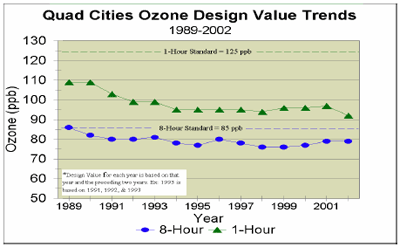Iowa Capital Dispatch
December 11, 2025
A federal judge has ruled federal animal-welfare inspectors can no longer conduct “courtesy visits” at dog-breeding operations while allowing violations to go unreported.
The ruling could... more
January 8, 2010 by editor
The U.S. Environmental Protection Agency (EPA) is planning to tighten the health standards for smog and the tougher regulations could impact Quad Cities industries and motorists.
Ground-level ozone forms when emissions from industrial facilities, power plants, landfills and motor vehicles react in the sun, and is linked to a number of serious health problems, ranging from aggravation of asthma to increased risk of premature death in people with heart or lung disease. Ozone also can harm healthy people who work and play outdoors.
The EPA is proposing to replace the standards set by the previous administration, which many believe were not protective enough of human health.
“EPA is stepping up to protect Americans from one of the most persistent and widespread pollutants we face," EPA Administrator Lisa P. Jackson said. "Smog in the air we breathe poses a very serious health threat, especially to children and individuals suffering from asthma and lung disease. It dirties our air, clouds our cities, and drives up our health care costs across the country.”
The agency said it plans to propose a “primary” standard, which protects public health, at a level between 0.060 and 0.070 parts per million (ppm) measured over eight hours.
In the Iowa Quad Cities, the current 8-hour smog level has averaged 0.065 ppm over the past three years, and in the Illinois Quad Cities the level has averaged 0.063 ppm over the same 3-year span, according to Bi-State Regional Commission officials.

To reduce ozone levels in the Quad Cities and avoid more stringent federal air regulations, Bi-State formed an air quality group in 2002 to develop a voluntary plan to cut ground-level ozone. The result (which included a memorandum of agreement with the U.S. EPA) was the "Quad Cities Voluntary Ozone Flex Plan" completed in 2003.
Children are at the greatest risk from ozone, because their lungs are still developing, they are most likely to be active outdoors, and they are more likely than adults to have asthma. Adults with asthma or other lung diseases, and older adults are also sensitive to ozone.
EPA is also proposing to set a separate “secondary” standard to protect the environment, especially plants and trees. This seasonal standard is designed to protect plants and trees from damage occurring from repeated ozone exposure, which can reduce tree growth, damage leaves, and increase susceptibility to disease.
The EPA last year reported it would reconsider the existing ozone standards, set at 0.075 ppm in March 2008. As part of its reconsideration, EPA conducted a review of the science that guided the 2008 decision, including more than 1,700 scientific studies and public comments from the 2008 rulemaking process. EPA also reviewed the findings of the independent Clean Air Scientific Advisory Committee, which recommended standards in the ranges proposed today.
Depending on the level of the final standard, the proposal would yield health benefits between $13 billion and $100 billion. The lower standards would help reduce premature deaths, aggravated asthma, bronchitis cases, hospital and emergency room visits and days when people miss work or school because of ozone-related symptoms. Estimated costs of implementing this proposal range from $19 billion to $90 billion.
EPA will take public comment for 60 days after the proposed rule is published in the Federal Register. The agency will hold three public hearings on the proposal: Feb. 2, 2010 in Arlington, Va. and in Houston; and Feb. 4, 2010 in Sacramento.
More information on the rulemaking and smog is available at: http://www.epa.gov/groundlevelozone
Iowa Capital Dispatch
December 11, 2025
A federal judge has ruled federal animal-welfare inspectors can no longer conduct “courtesy visits” at dog-breeding operations while allowing violations to go unreported.
The ruling could... more
Lee Enterprises, Inc. – owner of the QC Times, the Dispatch-Argus and some 70 other newspapers and online new sites nationally – lost $37.5 million during its 2025 fiscal year ended Sept. 29.
For the fourth quarter, the media company headquartered in Davenport lost $6.4 million.
... more
by Cami Koons, Iowa Capital Dispatch
November 28, 2025
The Iowa Department of Natural Resources is seeking feedback on its 25-year wildlife action plan, which must be reviewed every 10 years per federal law.
The action plan,... more
The Region 7 administrator for the EPA sent out a news release recently (11/18) patting the back of the Iowa Department of Natural Resources (IDNR) and "local businesses" for reducing SO2 (sulfur dioxide) pollution, enabling Muscatine to achieve compliance with national air quality standards.... more
Powered by Drupal | Skifi theme by Worthapost | Customized by GAH, Inc.

